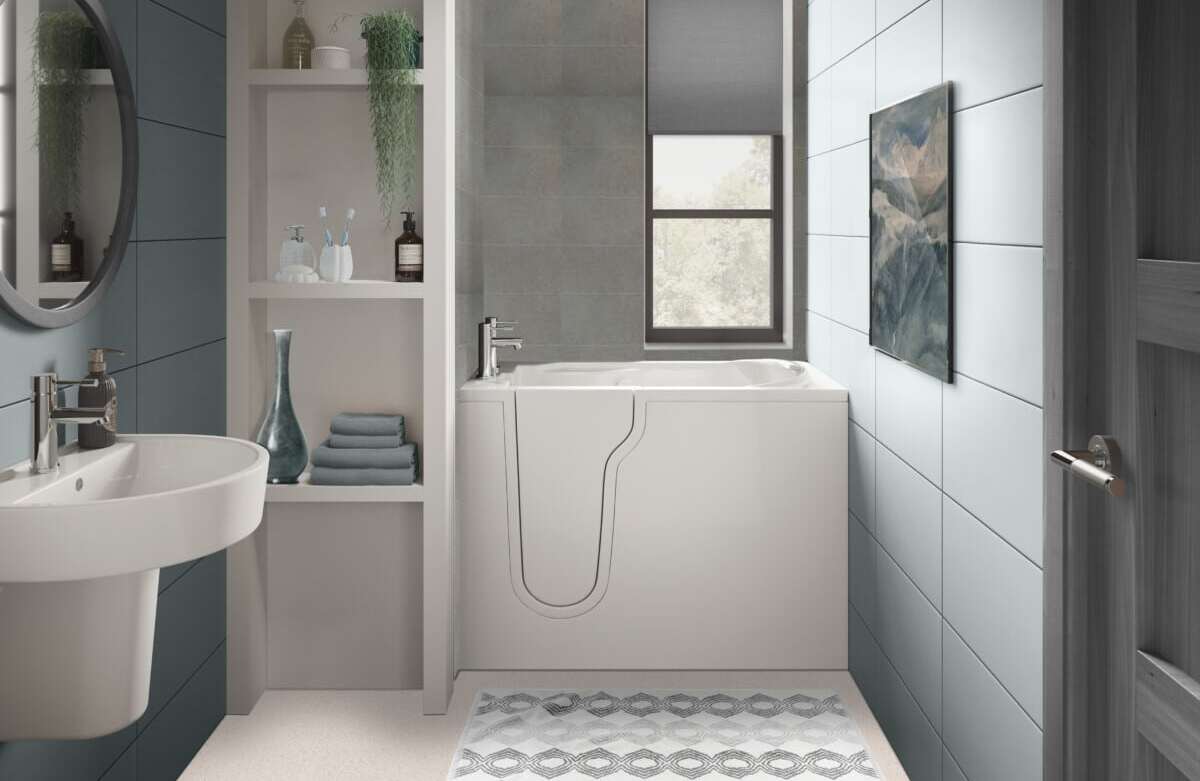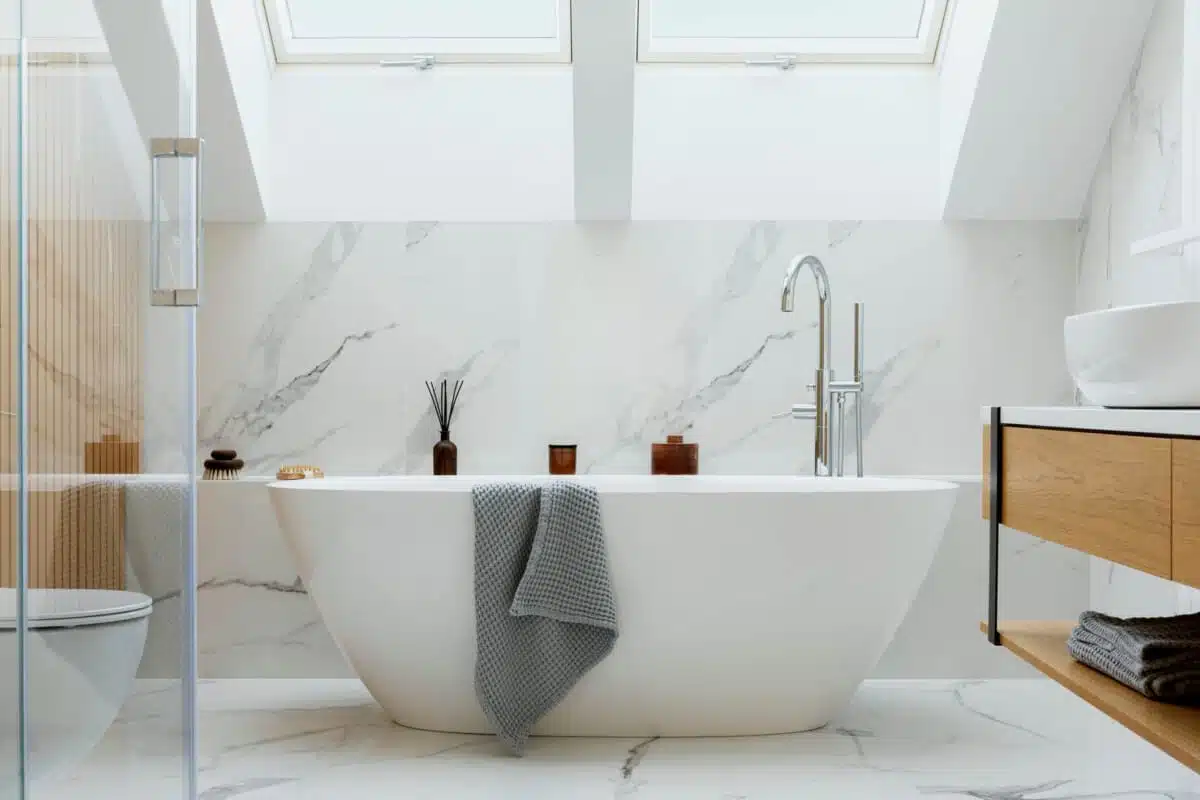How to Choose the Right Bath Size for Your Bathroom

Let’s be honest, choosing a bath isn’t just about looks – even if you’ve had your heart set on that beautiful freestanding rolltop. You’ve got to think about comfort, practicality and how it fits into your space. What room are you creating? Is it a cosy en-suite or are you planning the ultimate soak zone in a big family bathroom? These are all things you need to think about when finding the right bath size for your desired room.
Luckily, there are plenty to pick from too. From snug tubs to roomy freestanding options, we’ll walk you through everything you need to know and consider before making the big purchase.
What Are the Available Bath Sizes?
Need a quick size check? We’ve compiled a handy list of common bath dimensions in the UK, these are:
- 1400mm x 700mm
- 1500mm x 700mm
- 1600mm x 700mm
- 1700mm x 700mm (the classic go-to)
- 1700mm x 750mm
- 1800mm x 800mm
- Compact tubs starting from 1200mm long
These give you a good idea of what to expect when you begin to start shopping around. Of course, the right fit depends on your space, needs and preferences, so let’s break it down further and consider what is the correct choice for you.
What Is a Standard Size Bath?
Bath tub sizes vary significantly. But if you’re looking for the most common size that ticks most boxes, it’s 1700mm long by 700mm wide. This is what most UK homes go for because it’s the sweet spot between comfort and space-saving. You’ll find that it fits nicely into the standard, UK average-sized bathroom and will still give you room to stretch out, enjoy the bubbles and not feel cramped.
That said, it’s not your only option – as we’ve already discussed, there are a whole host to pick from. So, if you’ve got a smaller bathroom (one that may not fit the UK standard) don’t worry – there are plenty of shorter tubs that won’t take up all your floor space, and still be a comfortable option to bathe in. And if you’re lucky enough to have a bigger bathroom, you’ve got room to go larger for the ultimate spa-worthy soak, or you can even explore freestanding and statement options. Let’s get started figuring out your personal options…

How to Measure Your Bath
You’ve decided you need (or want!) a new tub, but before we dive straight into purchasing, let’s take a few moments to measure your current bath or, if you’re creating a bathroom from a blank canvas, the space in which your new one’s going to sit. You’ll want to get it right the first time, so you’re not battling with fittings or even returns at a later date. Here's what you need to measure:
Length
This one’s easy – it’s the end-to-end measurement of your bath (or the space in which you want it to fit). Standard lengths start at around 1400mm and go up to 1800mm. If your bathroom is narrow, you might want to go for a compact option.
Width
This is the side-to-side measurement. The typical width is 700mm, but if you like a bit more elbow room, some tubs go up to 900mm. If you’re working with a blank canvas, consider how much width you can play with, but make sure you don’t overdo it.
Height
Measure from the floor to the top edge of the bath. Built-in baths are usually lower, making them easier to step into. Freestanding or roll-top baths tend to be taller and offer a stylish, statement look. Again, if you’re starting with a blank space, height isn’t really an issue at this point.
Depth
This tells you how deep the bath is inside and how much water it holds, basically. If you like a long soak, look for something deeper. Just bear in mind that deeper baths might be trickier to get in and out of if mobility is a concern. And if mobility is a concern of yours, there is always the option of walk-in baths.
Get a FREE Brochure
Fill out the form in seconds and discover our full range of assisted bathing showers and baths.

What are the typical bath sizes available?
Every bathroom is different, and on that wavelength, so is every bath. Let’s look at the most common types and their usual sizes to help you find your perfect match.
-
Single-Ended Baths
Your classic go-to, found in a lot of homes across the country. Taps and waste are at one end, and the other end is for reclining and enjoying your time in the water. We think they’re perfect for smaller spaces or en-suites.
Common size: 1500mm–1700mm long, 700mm wide
-
Double-Ended Baths
Great for sharing or just sprawling out. Taps are in the middle, so both ends are usable for lying back and enjoying the comfort of tap-free space.
Common size: 1700mm–1800mm long, 700mm–800mm wide
-
Corner Baths
Have you got a short, compact floorspace? Corner baths are ideal if you’ve got an awkward layout or want to make the most of a corner. They save floor space and can offer a sleek appearance in any bathroom.
Common size: 1200mm–1500mm along each wall
-
L-Shaped Shower Baths
Love a bath but want the versatility of a shower as well? These L-shaped designs are great for a family bathroom where you need a practical shower space and a relaxing bath. The L shape gives extra standing room, too.
Common size: 1700mm x 850mm at the wider end
-
P-Shaped Shower Baths
These are similar to the L shape, but instead of the contemporary clean straight lines, they have a gentle curve for a softer look. We think they’re a great fit for any bathroom and give you that same versatility.
Common size: 1700mm x 850mm at the curve
-
B Shape Shower Baths
These are a newer silhouette in the bathroom industry. Have you seen them? They have curves at both ends, creating a stylish and spacious spot to soak, and it’s a little bit different to create a focal point. Plus, you’ll get plenty of room to shower and a comfy soak.
Common size: 1700mm x 900mm
-
Freestanding Baths
Freestanding roll-tops are a favourite in luxury homes. These look amazing in larger bathrooms and really make a statement. Great for those who love a long soak or want that spa aesthetic.
Common size: 1500mm–1800mm long, 700mm–900mm wide
How to Choose the Right Bath Size For You
Okay, so how do you actually decide on which of these is perfect for you? There are a few things you’ll want to think about before picking your tub, and we’ve written them all here as a handy checklist:
- Size of your bathroom – Measure up carefully so you don’t end up with a bath that overwhelms your space, or feels too small and compact.
- Who’s using it – If it’s mainly for kids, a shorter bath might do the trick. If you want something spa-worthy, go larger.
- Mobility needs – Shallower baths or ones with lower sides are easier to get into. Consider a walk-in bath if accessibility is important.
- Plumbing – Where are your pipes and waste outlets? Check before you pick a spot that’s inappropriate.
- Look and feel – What style and aesthetic do you want? This can help play into the decision.
A good bath isn’t just about the right fit; it’s about how it slots into your home and lifestyle. Some people prefer a quick morning shower, where an L-shape bath would be perfect, while others love to spend all evening in a deep soak, so a roll-top would be amazing. And if you’re working with a small space, don’t be disheartened – there are still plenty of options to pick from.
Finding the perfect bath size is all about what works for you, your space and your family. You want something that fits your space well without overpowering, one that suits your needs (considering mobility needs) and looks great too. Whether you’re going classic with a single-ended tub or fancy a freestanding rolltop, there’s something out there for everyone.
We’re always happy to help you find a bath that ticks all your boxes, just get in touch and one of our friendly team will guide you!
FAQs
Are all baths 700mm wide?
Not all of them. 700mm is the most common width, but many baths come in 750mm, 800mm or even wider if you’re after extra comfort.
What is the ideal size for a bath area?
Ideally, you want to leave at least 10cm of extra space around the bath for fitting and finishing touches.
What size is a full bath?
A “full-size” bath in the UK is generally 1700mm x 700mm. It means there is plenty of room for the average adult to sit in and soak.
